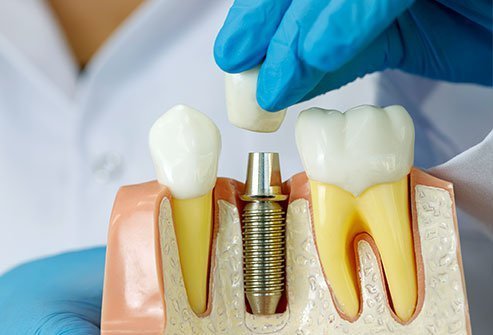Dental implants have revolutionized modern dentistry, offering a durable and aesthetically pleasing solution for those missing one or more teeth. Unlike dentures or bridges, dental implants provide a permanent fix, closely mimicking the look, feel, and function of natural teeth. However, the process of getting dental implants can be daunting, especially for individuals with dental anxiety. Understanding the procedure—what happens before, during, and after—can help alleviate fears and ensure a smoother experience.
Before the Procedure: Preparation and Planning
The journey to getting dental implants begins with a comprehensive consultation. During this initial stage, your dentist or oral surgeon will evaluate your oral health to determine whether you are a suitable candidate for the procedure. This assessment typically includes a review of your medical history, a physical examination of your mouth, and imaging tests such as X-rays or CT scans. These steps are crucial in identifying the density and volume of your jawbone, which will support the implant.
For those with dental anxiety, this preparatory phase is an excellent time to discuss your concerns with your dentist. Many practices offer various forms of sedation or relaxation techniques to help ease anxiety. Understanding the procedure in detail can also help mitigate fears. Your dentist will explain each step of the process, discuss the type of implant that will be used, and outline a personalized treatment plan.
In some cases, additional procedures may be necessary before the implant can be placed. For instance, if your jawbone is not dense enough to support an implant, you may require a bone graft. This procedure involves transplanting bone tissue to strengthen the area where the implant will be placed. Bone grafting can add several months to the treatment timeline, but it is essential for ensuring the long-term success of the implant.
During the Procedure: The Surgical Placement
On the day of the surgery, you’ll be prepared for the implant placement. Depending on your comfort level and the complexity of the procedure, local anesthesia, sedation, or general anesthesia will be administered to ensure you remain comfortable throughout.
The surgical procedure itself involves several steps. First, the dentist will make a small incision in the gum tissue to expose the jawbone. Then, a hole is drilled into the bone where the implant, a titanium post, will be placed. This post acts as an artificial root, anchoring the implant securely within the jaw.
After the post is in place, the gum tissue is sutured over the implant. Over the next few months, a process called osseointegration occurs. During this time, the implant fuses with the surrounding bone, creating a strong and stable foundation for the artificial tooth. Osseointegration is crucial for the long-term success of the implant, ensuring that it can withstand the forces of biting and chewing.
For patients with dental anxiety, the thought of undergoing surgery can be overwhelming. However, the use of modern sedation techniques and anesthesia ensures that the procedure is virtually pain-free. Patients often report feeling minimal discomfort during and after the surgery, with many comparing it to a routine dental extraction.
After the Procedure: Healing and Recovery
Following the surgical placement of the dental implant, the healing process begins. It’s common to experience some swelling, bruising, and mild discomfort in the days following the procedure. Your dentist will prescribe pain relievers and antibiotics to manage these symptoms and reduce the risk of infection.
Adhering to your dentist’s post-operative care instructions is essential for a smooth recovery. This may include eating soft foods, avoiding strenuous activities, and practicing good oral hygiene. Proper care during the healing period will help ensure the success of the implant and reduce the likelihood of complications.
For patients with dental anxiety, the post-operative phase can be challenging, as lingering discomfort may trigger feelings of unease. However, regular follow-up appointments with your dentist can provide reassurance. During these visits, your dentist will monitor the healing process, address any concerns you may have, and ensure that the implant is integrating properly with the bone.
Once the implant has fully integrated with the jawbone, the final phase of the treatment can begin. This involves placing an abutment—a small connector post—on top of the implant. The abutment serves as the attachment point for the artificial tooth, which is custom-made to match the color, shape, and size of your natural teeth. The final result is a seamless, natural-looking smile that restores both function and aesthetics.
Overcoming Dental Anxiety Throughout the Process
Dental anxiety is a common concern that affects many patients undergoing dental procedures, including implants. The fear of pain, the unknown, or past negative experiences can contribute to heightened anxiety. However, there are several strategies to help manage these feelings and ensure a more comfortable experience.
Open communication with your dentist is key. Expressing your concerns allows your dentist to tailor the treatment to your needs, whether that involves providing additional information, offering sedation options, or scheduling extra time for breaks during the procedure. Additionally, practicing relaxation techniques such as deep breathing, meditation, or listening to calming music can help reduce anxiety.
Some patients find comfort in bringing a friend or family member to the appointment for support. Distraction techniques, such as focusing on a specific point in the room or counting in your head, can also help shift your attention away from the procedure.
Dental implants offer a long-lasting solution for replacing missing teeth, providing both functional and aesthetic benefits. Understanding the dental implant process—from the initial consultation to the final restoration—can help demystify the procedure and alleviate any associated dental anxiety. By working closely with your dentist and following their recommendations, you can achieve a successful outcome and enjoy the many benefits that dental implants have to offer.



